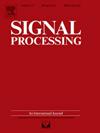Sparse channel estimation and passive beamforming with practical phase shift model for IRS-assisted OFDM systems
IF 3.4
2区 工程技术
Q2 ENGINEERING, ELECTRICAL & ELECTRONIC
引用次数: 0
Abstract
Intelligent reflecting surfaces (IRS) enable control of wireless propagation environments and have emerged as a highly promising and cost-effective technology for elevating the performance of future wireless communication systems. Obtaining the passive beamforming gain requires accurate channel state information (CSI), despite the practical challenge posed by its passive reflecting elements, which lack transmitting or receiving capability. Prior research on IRS has mostly used an ideal phase shift model, which assumes that every element reflects the signal fully irrespective of its phase shift. However, achieving this in real-world situations is difficult. This paper proposes a practical phase-shift model that takes into account phase-dependent changes in amplitude within the subgrouping reflection coefficient. This paper presents a new formulation for sparse channel estimation and passive beamforming in IRS subgrouping-assisted orthogonal frequency division multiplexing (OFDM) systems, leveraging a practical phase-shift model. Channel sparsity in the time domain is exploited, taking into account the physical proximity of passive elements and utilizing common sparsity shared among different subgroups using the variational Bayesian inference (VBI) framework. Furthermore, we proposed a stochastic majorization-minimization (SMM) based approach to optimize the IRS phase shifts to maximize the achievable sum-rate for the system, accounting for the practical phase-shift model. The results of the simulation validate the efficiency of the proposed channel estimation and passive beamforming method, showing substantial performance enhancements compared to existing cutting-edge techniques.
基于实际相移模型的irs辅助OFDM系统稀疏信道估计和无源波束形成
智能反射面(IRS)能够控制无线传播环境,并且已经成为一种非常有前途和具有成本效益的技术,可以提高未来无线通信系统的性能。无源波束形成增益需要精确的信道状态信息(CSI),尽管其无源反射元件缺乏发射或接收能力,给实际应用带来了挑战。先前的IRS研究大多采用理想相移模型,该模型假设每个元素都充分反射信号,而不考虑其相移。然而,在现实世界中实现这一点是很困难的。本文提出了一种实用的相移模型,该模型考虑了子群反射系数内振幅的相位相关变化。利用一种实用的相移模型,提出了IRS子群辅助正交频分复用(OFDM)系统中稀疏信道估计和无源波束形成的新公式。考虑到被动元素的物理接近性,利用变分贝叶斯推理(VBI)框架利用不同子群之间共享的公共稀疏性,利用时域信道稀疏性。此外,考虑到实际相移模型,我们提出了一种基于随机最大化最小化(SMM)的方法来优化IRS相移,以最大化系统可实现的和率。仿真结果验证了所提出的信道估计和无源波束形成方法的有效性,与现有的前沿技术相比,性能有了实质性的提高。
本文章由计算机程序翻译,如有差异,请以英文原文为准。
求助全文
约1分钟内获得全文
求助全文
来源期刊

Signal Processing
工程技术-工程:电子与电气
CiteScore
9.20
自引率
9.10%
发文量
309
审稿时长
41 days
期刊介绍:
Signal Processing incorporates all aspects of the theory and practice of signal processing. It features original research work, tutorial and review articles, and accounts of practical developments. It is intended for a rapid dissemination of knowledge and experience to engineers and scientists working in the research, development or practical application of signal processing.
Subject areas covered by the journal include: Signal Theory; Stochastic Processes; Detection and Estimation; Spectral Analysis; Filtering; Signal Processing Systems; Software Developments; Image Processing; Pattern Recognition; Optical Signal Processing; Digital Signal Processing; Multi-dimensional Signal Processing; Communication Signal Processing; Biomedical Signal Processing; Geophysical and Astrophysical Signal Processing; Earth Resources Signal Processing; Acoustic and Vibration Signal Processing; Data Processing; Remote Sensing; Signal Processing Technology; Radar Signal Processing; Sonar Signal Processing; Industrial Applications; New Applications.
 求助内容:
求助内容: 应助结果提醒方式:
应助结果提醒方式:


